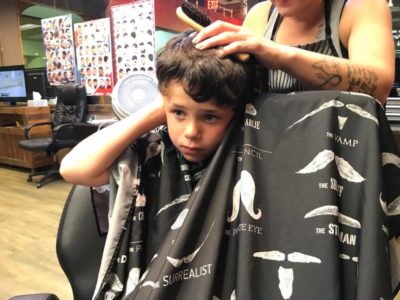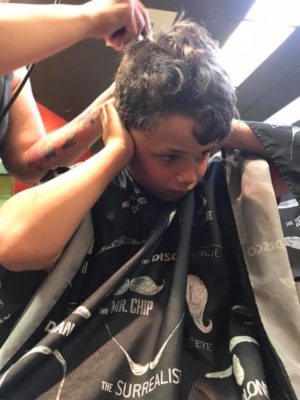
By: Brianna Mittelsteadt, OTR/L
Many people find going to the salon or barber shop a treat; scalp massages, a fresh new look, lovely smelling shampoo, maybe even a sucker when you are done. There are many individuals who have the opposite experience: children and individuals with sensory processing difficulties. Let’s quick talk about what sensory processing difficulties mean.
Sensory processing refers to how the nervous system receives sensory information and processes or interprets it through the brain. When an individual has sensory processing difficulties, this information does not get organized appropriately. In turn, we may see maladaptive responses, such as becoming overstimulated in a visually busy environment, covering their ears or running away when hearing ordinary sounds (toileting flushing, vacuum, blender, etc.), disliking touch or tactile input to various areas of the body, seeking or exerting too much pressure when engaging with toys or peers, difficulties with balance and coordination, and trouble sequencing or performing daily tasks consistently. Sensory processing difficulties in the area of touch or tactile input can significantly impact one’s ability to successfully perform self care tasks such as brushing teeth, taking a bath, trimming nails, washing face and hands, tolerating soap, eating a variety of foods and textures and…..haircuts!

Meet Grant! Grant is a 7 year old boy who has a diagnosis of autism. Grant is not a big fan of getting haircuts! During a haircut, Grant experiences several forms of sensory defensiveness/processing difficulties. One of these difficulties includes auditory defensiveness.
Auditory refers to sound. We can observe Grant’s defensiveness when he covers his ears. The sounds of the salon overwhelm him. In this instance, the trimmer is the culprit. He blocks out unwanted or alarming sounds by reducing the stimuli (covering his ears), but there are likely other sounds (such as the blow dryers and other people talking) that may also overwhelm him. Another sensory processing difficulty that Grant experiences is tactile sensitivity.
Tactile refers to touch. During a haircut, some of the tactile stimuli includes the stylist/barbers hands on his scalp, shoulders, neck, and ears. It can also be the feeling of a pokey comb, abrasive brush, squirting of water on his skin and hair, or the vibration of the trimmer. Even things as small as the cape on his neck and arms can provide tactile information that is aversive.
Another sensory consideration is olfactory stimuli. Olfactory refers to the ability to smell. Olfactory defensiveness can occur when smells become obnoxious or unbearable. Sometimes this shows itself in the form of headaches, burning sensation in the nose, watery eyes, rubbing eyes, stomach aches after prolonged exposure, etc.
Individuals who process sensory information typically may not “notice” all of this sensory input with the degree of detail that individuals with sensory processing difficulties do. Our (neurotypical) bodies/brains learn to expect this sensory stimuli through observation and experience. Our brains will formulate typical/predictive responses based on all the information we have taken in and processed. This leaves us with a feeling of security about the repeated experience of getting a haircut. In Grant’s case, this experience is hard work. His brain operates differently. For Grant, each time he has these sensory experiences, it is like new information to his brain each time he encounters them. When occupational therapists talk about “integrating” sensory or motor information, this is what we mean. If an experience has been “integrated” into the brain, the brain recognizes that this has been experienced before; therefore it can “ignore” irrelevant information and the experience can be calm and predictable.
For Grant, these overwhelming experiences can trigger anxiety and fear. Sometimes, but not always, this can lead to unwanted behaviors such as attempting to flee, crying, or defiance. When Grant becomes overwhelmed with sensory stimuli, he attempts to run away, covers his ears, squeezes your arm, or avoids the situation altogether by completing a calming activity such as looking out the window.
How do we manage or help decrease these sensitivities during the course of a haircut?
Occupational therapists are uniquely trained in managing sensory processing difficulties. We provide “sensory diet strategies” to assist with decreasing defensive behaviors during daily or regular activities. Here are a few strategies that we have used (and helped families use) to make a haircut easier. Keep in mind that each child is different and some strategies may work better than others. Some visual strategies to help prepare for a future haircut may include: a social story with pictures to help them know what they will experience, in order to feel more prepared, visiting the salon ahead of time to observe the environment and examine the tools, facing the child away from the mirror, having the child watch a movie or favorite cartoon, “practicing” or simulating a haircut in the clinic and at home.
Auditory strategies may include: Using a scissors versus an electric clippers, scheduling a time when the salon is not as busy, skipping the blow dryer, or providing the child with earbuds to watch a video.
Tactile strategies may include: Completion of Wilbarger brushing prior to the haircut, providing calming deep pressure such as a weighted lap pad, desensitizing the scalp by providing deep pressure or massaging, simulating vibrating input to head at home or therapy with a massager in times leading up to a haircut, bringing a shirt to change into after the haircut, providing a snack or drink, and eliminating a step, such as washing.
Olfactory strategies may include: Eliminating gel or hairspray, using unscented shampoo or conditioner, reducing other smells in the room such as perfume or air fresheners.
Behavioral strategies may include: Allowing the child to bring a preferred task of choice (iPad, music, toy, etc.) to be a calming distraction, providing a fidget, giving the child consistent positive reinforcement.
Environmental strategies may include: Bringing the child at a time where there are less people at the salon/barber, seeking a place that has booths with closing doors or less employees to help reduce sensory input, finding a hairstylist who is patient and has experience with children who have sensory processing difficulties.
The overall goal is to create an experience that is positive…or if not totally positive….at least one where the anxiety level can be decreased. Often times patience can go a long way. It helps to seek out a stylist or barber who is willing to spend a little extra time to ensure that the event does not become traumatic. A positive experience can help shape a routine for future (successful!) haircuts.
If haircuts are a challenge for your child, it is possible that they have sensory integration difficulties. Red Door offers a free screen where the family can meet with an occupational therapist to further discuss questions and concerns. Following the screen, the therapist may recommend a comprehensive evaluation to further assess sensory processing difficulties if that is deemed appropriate at the time.
